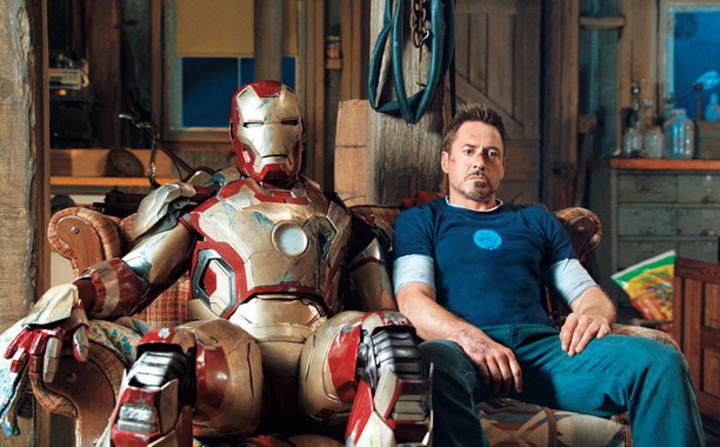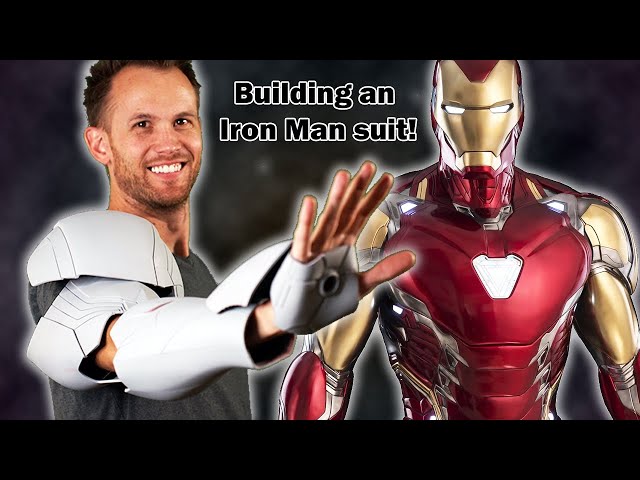How to make a Iron Man suit? It is a question every Marvel fan and tech enthusiast has asked at some point. While a fully functional, flying, weaponized Iron Man armor like Tony Stark’s remains science fiction, it’s absolutely possible to create a realistic version for cosplay or as a prototype using today’s technology.
Fans and makers worldwide have built impressive suits using materials such as EVA foam, fiberglass, and 3D printing. Others take it further by adding LED lights, voice modulators, or even limited-mobility exoskeletons.
Whether you’re aiming for a fun costume, a display piece, or a tech-inspired project, building an Iron Man suit combines creativity, engineering, and imagination—bringing you one step closer to feeling like a real-life superhero.

Table of Contents
What Makes the Iron Man Suit So Iconic in Marvel?
The Iron Man suit is more than just a costume—it’s a symbol of technological innovation and superhero might. First introduced in comic books and later brought to life in the Marvel cinematic universe, Tony Stark’s armor became the epitome of futuristic design.
Its blend of science and engineering has thrilled fans for decades, with the suit’s functionality, like flight and advanced weaponry, contributing to its appeal. In the Marvel movies, the Iron Man suit showcases dazzling elements like powered exoskeletons, artificial intelligence, and propulsion systems that capture fans’ imaginations.
From the iconic arc reactor to the evolving alloy armor, the suit represents the ultimate combination of comic book fantasy and near-future technology, inspiring countless MCU enthusiasts to build an Iron Man suit of their own.
When you set out to create your own Iron Man, you’re not just crafting a costume; you’re embracing the spirit of inventiveness and the legacy of an Avenger who redefined what a superhero’s armor can be.
How to Design Your Own Iron Man Suit?
- Every great build begins with a solid design.
- Whether you want a perfect replica of Tony Stark’s armor or a one-of-a-kind custom Iron Man or Iron Woman look, planning is vital.
- Begin with references from comic books and the Marvel cinematic universe to find inspiration.
- Consider elements like the shape of the helmet, chest arc reactor, and the unique patterns in each version of Stark’s armor.
- Modern technology allows you to use 3D modeling software to visualize your suit.
- Softwares like Blender, Pepakura, or Fusion 360 are popular for superhero costumes.
- This digital step helps perfect the suit’s proportions and functionality before committing to physical materials.
- Even if you’re not making a “real Iron Man suit,” your design can incorporate aspects like joint mobility, electronics for lighting, and areas for custom iron man stickers.
- By investing time into the design phase, you ensure that your suit is not only visually stunning, but comfortable, practical, and tailored to your vision as a Marvel fan.
What Materials Do You Need to Build an Iron Man Suit?
- Choosing the right material is key for any Iron Man suit project.
- If you’re going the traditional DIY route, EVA foam is a superb choice—lightweight, flexible, and easy to work with, making it ideal for crafting wearable armor.
- EVA foam sheets can be shaped, sanded, and painted to resemble the metallic finish of Tony Stark’s suit, all while remaining comfortable for prolonged wear.
- If you’re aiming for higher detail and durability, 3D printing offers unmatched customization options.
- Using PLA or ABS plastics, you can print precisely-designed costume parts, from the helmet to the gauntlets, with incredible accuracy.
- The choice of material influences not only the look and feel of your suit, but its practicality, mobility, and weight.
- Remember to gather additional supplies like glue, paint, electronics for lighting the arc reactor, fasteners, and, if desired, pre-made iron man stickers.
- The right mix of material and technique will set your project on the path to success.
Which Is Better: Foam or 3D Print for Iron Man Costumes?
This is a common question for fans wanting to build their own Iron Man. Foam is affordable, lightweight, and relatively easy for beginners. It’s great for convention-ready iron man costumes where comfort, flexibility, and speed are priorities. The craft process with foam offers lots of room for adjustment and improvisation—a boon for creative fans.
On the other hand, 3D printing delivers high-detail, hard-shell components that closely match the aesthetic of the real iron man suit from the movies. The process is more time-consuming and requires access to 3D printers and technical knowledge of software and machine operation.
However, if you strive for a more “real-life iron man suit” feel, 3D printing is the gold standard—especially for helmets, intricate armor joints, and other mechanical elements.
Ultimately, your choice depends on budget, time, and desired functionality. Some creators even combine the two by using 3D-printed parts for structural pieces and foam for larger body panels, achieving the best of both worlds.

Step-by-Step: How to Build Your Own Iron Man Suit Using Foam
- To begin, select high-density EVA foam sheets.
- Use your finalized design or printed Pepakura templates to trace the armor pieces onto the foam.
- Carefully cut out each component, using a hobby knife for accuracy. Heat-shaping the foam with a heat gun is vital to achieve those iconic curves in Tony Stark’s armor.
- Next, assemble the pieces with hot glue or contact cement, ensuring strong seams for long-term wear.
- Sand and smooth all edges, then prime the suit for painting. Use metallic and red/gold paints to replicate the movie look, and finish with a protective sealant.
- Many fans add details like glowing eyes and a chest arc using LED lights and simple electronics for extra authenticity.
- The foam technique is practical and budget-friendly, making it a popular choice for fans wanting to create your own iron man costume for cosplay or display.
- You’ll be surprised by how much mobility and functionality you can achieve with this material, crafting a suit that truly feels “powered.”
How to Create an Iron Man Suit with 3D Printing
- 3D printing takes your build to a more advanced level.
- Begin with digital files—either download ready-made iron man suit models or design your own in CAD software.
- Divide the suit into printable sections, being mindful of printer bed size and assembly logistics.
- Print each piece using sturdy filament like PLA. After printing, sand and smooth all surfaces, then glue sections together as needed.
- Use primer to cover print lines, then paint in classic red and gold.
- Advanced fans might reinforce interior pieces with fiberglass for added structural strength.
- The biggest advantage of 3D printing is the chance to replicate intricate details from the movie, including mechanical textures, functional hinges, and accurate arc reactor designs.
- While more expensive and time-consuming than foam, the result is a stunning, highly-detailed armor—ideal for collectors, engineering buffs, and anyone who wants their version of tony stark’s suit to feel truly real-life.
Can You Add Electronics and Lighting to Your Suit?
Absolutely! Adding electronics brings your iron man suit to life. Most fans start by wiring LED lights for the arc reactor, hand repulsors, and helmet eyes, but you can also integrate sound effects, motorized faceplates, and even simple robotics using Arduino or Raspberry Pi systems.
For a real wow factor, include a basic heads-up display in the helmet or animatronic features that mimic the movie’s high-tech marvel. Building electronic functionality not only elevates your costume from prop to powered device, it’s a great way to explore the technology side of Stark’s armor and improve your science and engineering skills.
Safe electrical design is crucial—always insulate wires, use proper battery packs, and secure all electronics to prevent short-circuits. This step transforms your suit from a simple costume to a real machine, blurring the line between fictional and functional.
What Are the Challenges in Making a Real-Life Iron Man Suit?
Every “build your own iron man” project faces challenges. The first is mobility: achieving a snug yet wearable suit with movable joints can get complicated, especially if you want functionality like in the marvel movies.
Real-life materials (whether foam or hard plastic) can restrict movement, so planning for strategic hinge placements and padding is key. Weight and balance are other concerns, especially with 3D printed or reinforced materials.
Maintaining comfort while achieving the desired look takes careful design and trial-and-error. And, of course, integrating electronics and lighting without overheating or overcomplicating the build can be tricky—requiring a good understanding of system layout and power source management.
Don’t let these obstacles deter you! Remember, even Tony Stark’s first suit was the product of ingenuity, not perfection. Treat these hurdles as part of the learning process and enjoy the engineering journey.
Could You Really Fly with an Iron Man Suit? The Science and Engineering Explained
It’s the ultimate question: could you make the iron man suit fly? While powered exoskeletons and propulsion systems are real fields of study in aerospace and robotics, current technology can’t yet match the movie magic.
Jet suits like those from Gravity Industries use mini propulsion devices to achieve real, short-duration flight, but their capability, fuel use, and device size come nowhere near the compact, silent efficiency of a fictional iron man suit.
The nearest real-life iron man suit is more likely to be a powered exoskeleton that enhances strength and mobility, already in use in military and rehabilitation contexts.
Advances in artificial intelligence and lightweight titanium alloys hint at intriguing possibilities for the near future. For now, flight remains limited in duration and practicality, but science and engineering continue to narrow the gap between Marvel and reality.
How to Personalize and Display Your Completed Iron Man Costume
Once you’ve completed your suit, it’s time to show it off! Personalize your armor with battle damage effects, custom paint schemes, iron man stickers, or Avenger-themed accessories.
Adding unique design touches, LEDs, or even sound chips can make your suit truly one-of-a-kind and reflective of your own superhero style. For display, consider building a mannequin stand or acrylic case to protect your hard work.
Whether you intend to wear your suit to conventions, parties, or simply as a showpiece, the satisfaction of having created an iron man suit using foam, 3D print, or hybrid methods is second to none. Share your success with the online fan community, trading tips and celebrating others’ creations—a true mark of a Marvel fan.

FAQs
Is it possible to create an Iron Man suit?
A fully functional Iron Man suit like in the movies isn’t currently possible with today’s technology. Some aspects exist—like exoskeletons for strength, jetpacks for short flight, and advanced AI—but combining them into a compact, wearable suit with unlimited power isn’t achievable yet.
How does Iron Man make his suit?
In Marvel lore, Tony Stark builds the suit using advanced nanotechnology, high-strength alloys, arc reactor energy, and AI systems. In reality, nanotech and arc reactors don’t yet exist in the way depicted.
How to make Iron Man step by step?
Fans often build cosplay versions using materials like EVA foam, 3D printing, or fiberglass. Real exoskeleton research focuses on robotics, hydraulics, and powered frames. A true step-by-step Iron Man build isn’t possible with real tech yet.
How to make an Iron Man?
You can’t “make” a real Iron Man with current science, but engineers are working on powered suits for military and medical use, such as Sarcos Robotics exoskeletons.
Is Iron Guy a hero or villain?
There isn’t an “Iron Guy” in Marvel canon—likely a confusion with Iron Man, who is a hero (though complex and sometimes morally grey).
Is a real Iron Man suit possible?
Partially. We have pieces:
Exoskeletons (assist strength/mobility).
Jetpacks (short controlled flight).
Wearable AI assistants (basic versions exist).
But a self-contained suit with flight, weapons, and unlimited energy like Tony Stark’s remains science fiction.
Can Iron Man’s suit fly?
In the comics and films, yes. In real life, jetpacks can achieve short flights, but nothing near the control, range, or speed shown in Marvel.
What is Iron Man’s IQ?
Tony Stark is often cited as having an IQ of 270, making him one of the smartest characters in the Marvel universe. This is fictional, of course.
Key Takeaways: Building Your Own Iron Man Suit
- Start with a solid design, referencing Marvel and comic inspiration.
- Choose materials based on your project: foam for ease and comfort; 3D print for detail and structure.
- Foam suits are great for beginners and cosplay; 3D-printed armor is best for stunning replicas.
- Integrate electronics for lighting and function—practice good safety with wiring.
- Anticipate challenges with mobility, comfort, and material selection.
- Real-life Iron Man suits with flight aren’t practical yet, but rapid advances in robotics and aerospace show promise.
- Personalize your suit for a one-of-a-kind creation.
- Enjoy the build process—embrace both the science and craft involved.
- Engage with the fan community for support, ideas, and celebration of all things Iron Man.
Whether you’re making a costume for fun or seeking to replicate Stark’s armor with functional technology, your Iron Man suit project will be a rewarding journey through creativity, skill, and fandom!
Conclusion
Building an Iron Man suit is a dream for many Marvel fans, and while a fully functional version like Tony Stark’s remains science fiction, creating your own replica is very possible.
With materials like EVA foam, 3D printing, fiberglass, or even metalwork, you can design a detailed cosplay suit that looks impressive and wearable. Adding electronics, LED lights, and voice effects can make it even more authentic.
Real-world exoskeletons and jetpacks show that science is slowly catching up, but for now, hobbyists and makers focus on creativity and craftsmanship rather than flight or weaponry. Whether for cosplay, display, or personal challenge, making an Iron Man suit is about passion, imagination, and bringing a superhero vision to life.